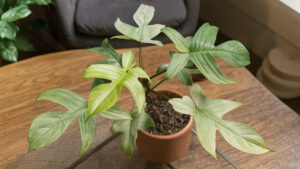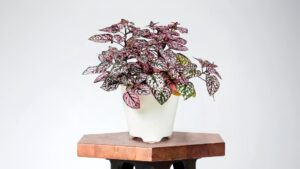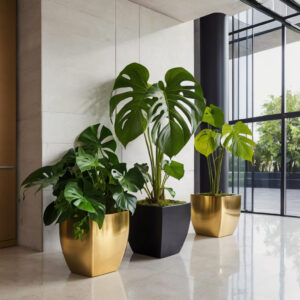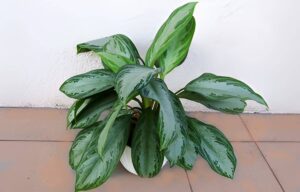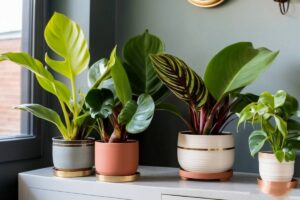
Dealing with pesky fungus gnats around your houseplants? These tiny, 1/8-inch flies are attracted to moist soil and can be a sign of overwatering. To tackle the issue, allow the soil to dry out before watering again, or use natural remedies like insecticidal soap, neem oil, or homemade peroxide spray. You can also create traps using sticky yellow cards or raw potato slices. By preventing overwatering and using these organic methods, you can effectively eliminate gnat invasions and ensure your indoor garden thrives.
In this article
- 1 Why are my indoor plants attracting gnats?
- 2 How to identify gnats in indoor plants
- 3 How to Get Rid of Gnats on Houseplants
- 3.1 Sticky fly traps are the best gnatcatcher
- 3.2 Smother your plant’s soil
- 3.3 Use the power of spuds
- 3.4 Spray vinegar on your plants
- 3.5 Use hydrogen peroxide
- 3.6 Lure Them to Sticky Cards
- 3.7 Food-Grade Diatomaceous Earth
- 3.8 Drench the Soil
- 3.9 Let Plants Dry Out Slightly
- 3.10 Soap and vinegar
- 3.11 Hydrogen peroxide
- 3.12 Coating the soil with sand
- 3.13 Repotting your plant
- 3.14 Frequently asked questions
Why are my indoor plants attracting gnats?
Gnats are tiny flying insects that are commonly found hovering around houseplants. There are a few reasons why gnats may be attracted to your indoor plant
- Overwatering – Gnats lay their eggs in moist soil, so too much watering can create the perfect breeding ground.
- Poor drainage – Dense, soggy soil that doesn’t drain well provides an ideal environment for gnats.
- Decaying organic matter – Gnats are drawn to decaying leaves, roots and other debris in the soil. This often happens when old potting mix breaks down.
- Lack of air circulation – Stagnant air around indoor plants allows gnats to thrive undisturbed.
- Nearby food sources – Gnats may fly in from compost piles or overripe fruit you have sitting out.
By identifying and correcting these conditions, you can make your plants less inviting to gnats looking for a place to spawn.
How to identify gnats in indoor plants
Here are some tips for recognizing gnat infestations in your houseplant.
- Look for small dark insects flying erratically around your plants, especially right above the surface of the soil.
- Use yellow sticky traps – gnats will stick to them, confirming their presence.
- Check for larvae in the top layer of soil. They look like tiny white worms wriggling around the roots.
- Allow the soil surface to fully dry out and then water again – this will bring gnats to the surface.
- Look for signs of decaying organic matter like soggy leaves or algae growth on the soil.
- Notice if plant leaves are turning yellow, wilting or dropping – this can indicate damaged roots from gnat larvae.
Catching an infestation early makes gnats much easier to get rid of before they multiply and damage your plants.
How to Get Rid of Gnats on Houseplants
There are many effective methods for eliminating gnats that won’t harm your plants. Here are some gnat-control tricks to try:
Sticky fly traps are the best gnatcatcher
Yellow sticky cards or strips placed in the pots of infected plants will attract adult gnats looking for a place to land and lay eggs. Traps near the soil surface will catch the most flies. Just be sure to keep the sticky traps away from leaves so they don’t get stuck.
Smother your plant’s soil
Spreading a thin layer of sand or fine gravel over the soil blocks gnats from reaching the surface to lay eggs. Small rocks also prevent soil from splashing up and releasing gnats when watering. Just leave a circle uncovered around each stem
Use the power of spuds
Placing raw potato slices on the soil and replacing them every few days kills gnats. As the slices start decomposing, they release solanine, a compound that is toxic to larvae and adults. Potatoes won’t harm your plants but keep them away from leaves.
Spray vinegar on your plants
A mix of equal parts white vinegar and water sprayed on the soil surface kills eggs and larvae on contact. The acetic acid in vinegar is harmless to plants when diluted but toxic to gnats. Reapply every few days until gnats are gone.
Use hydrogen peroxide
Mixing 3% household hydrogen peroxide with water to water infected plants kills larvae and dissolves gnat eggs. It provides oxygen to plant roots while eliminating grimy layers where gnats breed. Don’t use more than a 1:4 ratio of peroxide to avoid harming your plants
Lure Them to Sticky Cards
Place yellow sticky traps just above the soil to attract adult gnats looking for a place to land and lay eggs. The traps catch them before they can reproduce again. Just keep sticky cards away from leaves.
Food-Grade Diatomaceous Earth
Sprinkling diatomaceous earth on the soil dries out and cuts the exoskeleton of gnat larvae. The powdery fossilized remains of algae shreds the insects but is gentle for plant roots and leaves.
Drench the Soil
Water your plants with an insecticidal soap or neem oil drench to kill larvae in the soil. Make sure to fully saturate the dirt to eliminate all stages of the gnats’ life cycle. Let the soil dry out between treatments.
Let Plants Dry Out Slightly
Allow the soil surface to dry before watering again to disrupt the gnats’ breeding environment. The drying will kill eggs and larvae in the top layers of soil. Just don’t let plants get too stressed
Soap and vinegar
Mix a few drops of dish soap with an equal amount of vinegar in water. Spray this solution directly onto places where you see gnats gathered to break down their outer shells. It’s safe for plants in moderation.
Hydrogen peroxide
Watering with a diluted hydrogen peroxide solution introduces extra oxygen into the soil, creating an environment that gnat larvae cannot survive in. Use a 1:4 ratio of peroxide to water.
Coating the soil with sand
Cover the top layer of soil with a fine layer of sand. This blocks gnats from being able to lay their eggs in the soil and interrupts their life cycle. Just leave the area around the base of the plant uncovered.
Repotting your plant
Repotting plants in fresh, sterile potting mix eliminates gnat eggs and larvae hiding in old soil. When repotting, examine roots and prune off any that are damaged. This gives your plant a fresh start
Frequently asked questions
What are some signs of a gnat problem?
Flying insects around plants, larvae in soil, yellowing leaves, damaged roots.
How do gnats affect plants?
Larvae feed on roots damaging the plant. Adults carry diseases affecting leaves.
Are home remedies safe for plants?
Natural methods like hydrogen peroxide and diatomaceous earth won’t harm plants when used properly.
How can I prevent future gnat problems?
Allow soil to dry out between waterings, use sterile soil, remove plant debris, improve air circulation.
Will sticky traps hurt my plants?
Yellow sticky traps are safe when kept away from plant leaves and stems.
Gnats can be pesky but with consistent prevention and early intervention, you can eliminate invasions and keep your houseplants thriving. Start by inspecting plants regularly and addressing excess moisture that attracts gnats. Apply natural remedies like vinegar, peroxide and diatomaceous earth to kill larvae and disrupt breeding.
Keep plants healthy with proper light, water and drainage to avoid conditions gnats look for. With a multi-step approach, you can kick gnats (and other common indoor garden pests) out of your indoor garden for good.
Happy gardening!
